






“Remember that the happiest people are not those getting more, but those giving more.” – H. Jackson Brown Jr.
Volunteering is an excellent way for families to make a difference in their communities and offers lots of benefits to those who volunteer their time and skills.
What’s more, volunteering raises kids’ sense of civic responsibility. It’s a great skillbuilding experience and offers socialization opportunities for kids and adults alike. It also makes for an excellent bonding experience with grandkids.
Regardless of where you live, countless volunteer opportunities are available — and there’s something to fit every family’s talents and interests. So share these ideas with your grandkids to see what triggers their enthusiasm, and make a family plan to put it into action.
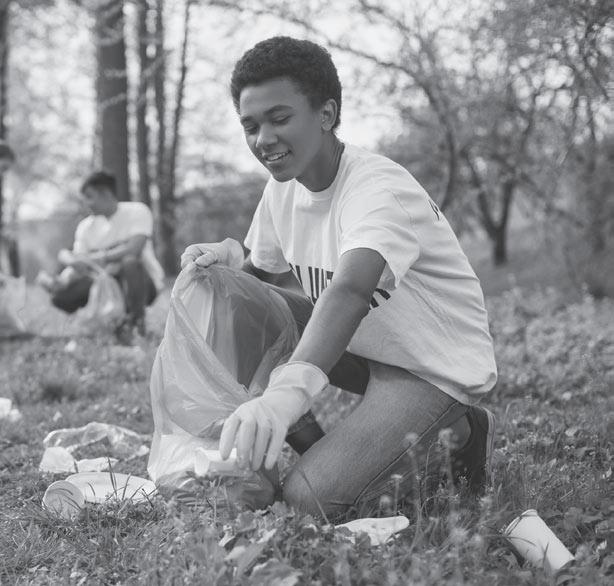
April is National Volunteer Month
Volunteer at a soup kitchen or food pantry. People who are impoverished or homeless are always in need of nutritious food and meals.
Search online for local soup kitchens and food pantries. Then call and speak to the manager and offer your family’s service. Be sure to mention the age of your grandkids in case there are age restrictions.
At a soup kitchen, you can help prepare and serve a meal or do kitchen cleanup. For a food pantry, help with stocking or putting together food baskets for families in need.
Some pantries also need delivery assistance, since many low-income families don’t have transportation to pick up their food supply.
Help out at an animal shelter. Cats and dogs spend days, weeks, and often longer cooped up in small kennels or crates with little opportunity to exercise or socialize. Offer to spend an afternoon walking dogs or playing with cats.
There are many other things you can do for a shelter, too. You can transport a pet to a new home, clean kennels, donate supplies, or help find loving homes through social media.
Adopt a road or park for cleanup. Most states have adopt-a-highway programs. These typically require a signed contract for a period of two to four years with a promise to clean up a designated area two to four times a year.
Alternatively, you could pick an unsightly city street and head out to clean up the debris. Keep kids safe by requiring them to stay off the road and pick up litter only on the boulevard. If you have younger grandkids, park cleanup is a safer option.
Paint a park bench. Benches can be found in parks as well as shopping districts and along bus routes. Contact your city hall or parks and recreation department and request permission to freshen up a bench. If your family is artistic, ask if you may do something creative to make it more cheerful.
Help build a house with Habitat for Humanity. This organization helps build and renovate homes for families in need of safe shelter. Visit habitat.org
to find your local Habitat organization, and ask how you can help. Habitat also offers a teen volunteer program.
Send letters to military members overseas. Veterans, new recruits, and deployed troops deserve and need to know just how much we appreciate their dedication and service to our country. For more information, visit operationgratitude.com/ writeletters.
Put together care kits for homeless shelters. Ask local businesses to donate items for the homeless care kits you plan to create.
The following are useful items to include in each kit: toothpaste, toothbrush, dental floss, comb, bar of soap, shampoo, package of hand wipes, razor, shaving cream, protein bars, and other small, useful items.
Any food items should be nonperishable and require no preparation.
Hold a bake sale for a charity. Pick your favorite charity and hold a bake sale to raise funds for it. Just ask a busy local business or grocery store if you can set up a table on a given day for your charity bake sale. Then invite family and friends to pitch in and help with the baking.
Plant seeds or greenery along a highway or main street. Check with your city first. Then contact management at local nurseries and ask them to donate plants or seeds for the project. Plant only native flowers, shrubs, and trees that won’t require watering or maintenance.
Rake, mow, or remove snow for a disabled person. If you don’t know anyone who’s disabled, ask coworkers or friends if they know of someone. Or do an online search for disability organizations in your area.
Kimberly Blaker is a freelance writer. She also owns an online bookshop, Sage Rare & Collectible Books, specializing in out-of-print, scarce, signed, and first editions; fine bindings; ephemera; and more at sagerarebooks.com.

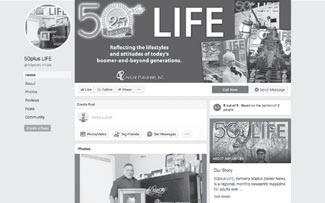




CoRpoRATE oFFiCE
P.O. Box 8049, Lancaster, PA 17604
Phone (717) 285-1350 (610) 675-6240
Fax (717) 285-1360
Email address: info@onlinepub.com
Website address: www.onlinepub.com
pRESiDENT AND pUBLiSHER
Donna K. Anderson
EDiToRiAL
Vice president and Managing Editor
Christianne Rupp Editor, 50plus publications
Megan Joyce
ART DEpARTMENT project Coordinator
Lauren Phillips
BUSiNESS DEVELopMENT Senior Marketing Consultants
Joshua Binkley
Angie Willis Events Manager
Kimberly Shaffer
ADMiNiSTRATioN Business Manager
Elizabeth Duvall

Awards


50 plus Life is published by On-Line Publishers, Inc. and is distributed monthly among senior centers, retirement communities, banks, grocers, libraries and other outlets serving the senior community.
On-Line Publishers, Inc. will not knowingly accept or publish advertising which may be fraudulent or misleading in nature.
Views expressed in opinion stories, contributions, articles and letters are not necessarily the views of the publisher. The appearance of advertisements for products or services does not constitute an endorsement of the particular product or service. The publisher will not be responsible for mistakes in advertisements unless notified within five days of publication. On-Line Publishers, Inc. reserves the right to revise or reject any and all advertising. No part of this publication may be reproduced or reprinted without permission of On-Line Publishers, Inc.
We will not knowingly publish any advertisement or information not in compliance with the Federal Fair Housing Act, Pennsylvania State laws or other local laws.
Most of us know the story of the child and the starfish. After a storm, thousands of starfish are washed up on the beach. A child walks by and starts throwing individual starfish back into the sea.
A passing adult admonishes the child that his efforts can’t make a difference because there are too many starfish to save. The child throws another starfish into the water and replies, “I made a difference to that one.”
Making a personal effort resonates with the mission of the Lancaster Farm Sanctuar y (LFS), says Jil Desso, 52, volunteer, part-time educational coordinator, and tour guide.
“We are surrounded by chicken, turkey, dairy, beef, and pig farms, all animals destined for someone’s dinner plate, but we focus on doing our part in making a difference for each animal that comes to the sanctuary.”
LFS has approximately 100 “residents,” including cows, pigs, sheep, goats, an alpaca, chickens, turkeys, and ducks. They are cared for by about 40 volunteers and one full-time and two part-time staff members.
Animals come to the sanctuary when they are abandoned, lost along a country road, or with health issues that make them undesirable at a neighborhood farm.
Once they come to the sanctuary, they receive medical care, food, water, and lots of love.
The sanctuary was founded by Sarah Salluzzo and her partner Jonina Turzi in 2016 to rescue farmed animals and provide them sanctuary, while inspiring humans to live with animals with compassion and respect. Desso began volunteering in 2021.
She explains the founders felt the need for a farm animal sanctuary since Lancaster County is a large hub for animal agriculture.
“Yet we’ve received phenomenal community support,” she explains.
As a nonprofit, LFS relies solely on donations that come in through small fundraisers throughout the year, monthly donations, Patreon members, the annual Extraordinary Give, and educational tours for visitors, Desso said.
With a master’s certificate in education, Desso has made a passionate commitment to educating young minds for nearly 30 years.
She has taught children in special needs and general elementary school programs and currently works part-time teaching English as a Second Language at the PA STEAM Academy in Harrisburg.
Now her passion includes helping educate the children and adults who tour the sanctuary each year. Tours include both public groups of about 20 that can be booked on the website lancasterfarmsanctuary.org. Private groups can also contact the staff for a more personal tour.
“We provide an honest education,” she explains. “We don’t go into graphic details of what happens to animals in animal agriculture, but we also don’t hide the truth. We want to plant seeds — and provide information so people want to know more.”
During the tours, visitors are introduced to the residents. All have a name and are presented as individuals who have a right to live their lives without pain and suffering.
Desso also leads another important part of the sanctuary’s outreach to the community, the Sanctuary Pen Pal Program for kindergarten through fifth-grade students.
“I send video clips from a few animals, and the class votes on which animal will be their pen pal, whether it’s Jude the cow, Ramona the pig, or one of the other residents,” she explains.
“We correspond back and forth. They learn to look at animals as individuals when they ask about their favorite colors, snacks, or who their friends are. We keep it positive. They end up making connections to the farm animals just as they do with the pets in their homes.”
Desso loves to tell stories about all the residents that have captured her heart.
“Each animal is different with their own personality, likes, dislikes, and quirks. Howie the pig likes to play with toys, loves apples, and comes running when I call his name.
“Jude and Claire are two cows that are close friends and have become inseparable,” she says. “Since in the farming industry, animal families aren’t usually kept together, they come here and find their own adopted families.”
Some close friends aren’t even the same species. On the sanctuary Facebook page (facebook.com/ lancasterfarmsanctuary), you’ll find Tig, the rooster, snoozing in the sunshine with Ralphie and Randy, two older pigs.
Currently, her volunteer shift is with birds in the sanctuary, including ducks, chickens, and turkeys.
“They follow me around, and we chat. Some have even fallen asleep in my lap,” she smiles. “They are amazing beings and just as snuggly as a cow or a sheep.
“When you spend time with these animals, you see that they feel joy, pain, grief, and attachment,”
says Desso.
“If an animal has to go to the hospital, their friend often cries out, shows sadness, stops eating, or is listless. When they return, there is often so much joy and excitement, it’s beautiful. They are no different from your pet dogs and cats.”
Desso’s personal journey to a vegan lifestyle began early.
“I had an aversion to eating meat and stopped eating it at age 13 or 14. It just didn’t seem right,” she recalls.
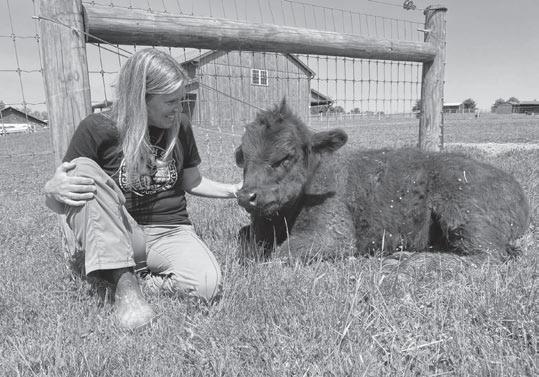
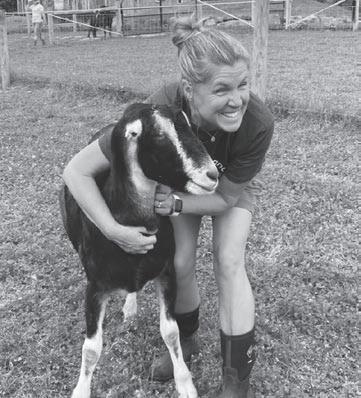
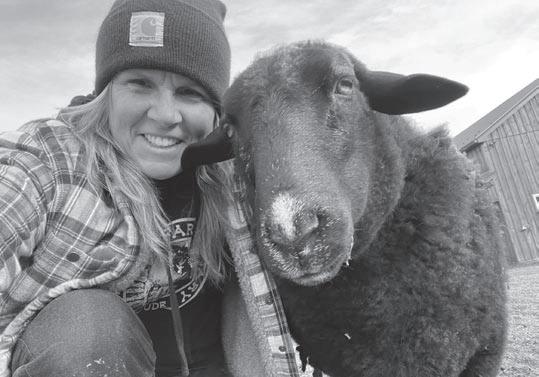
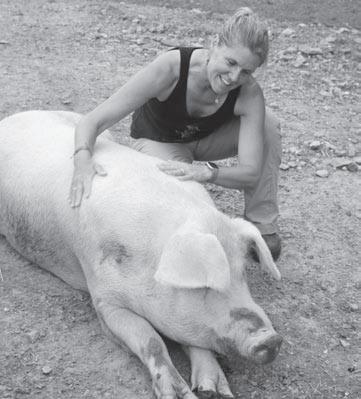
“In college I learned more about animal exploitation. I never liked eating animals, but my reasons for stopping have shifted.”
Four years ago, she became vegan and stopped using all animal products.
“I also stopped wearing leather shoes, wool sweaters, and other products from animals,” Desso said.
Her husband, Todd, and children Emma and Kaleb, both in college, support her path.
“I taught our children respect for all beings, no matter the culture, race, religion, or sexual orientation. That includes animals,” she says.
Desso points out that health and climate change are also factors that are encouraging some people to adopt a more plant-based lifestyle.
“It’s a misconception that we need to eat animals to be healthy,” she says.
Numerous European and U.S. studies, including research by the National Institutes of Health, link eating meat — especially red and processed meats — with an increased risk of disease, from heart disease to cancer.
Scientist s at the World Resources Institute have also shown that “shifting to diets with a greater share of plant-based foods could significantly reduce agriculture’s pressure on the environment.”
But for Jil Desso and the staff and volunteers at the Lancaster Farm


Sanctuary, their motivations focus on doing their part to reduce animal suffering and leading humanity to a kinder, more sustainable future through education.
“Animals are the bravest, strongest, most patient, and loving beings, and with time and care, they are also forgiving to humans,” says Desso. “They have taught me so much.”
She gets emotional when she summarizes, “I will always be part of the sanctuary. It’s a place where I can be fully myself, both with humans and animals.”
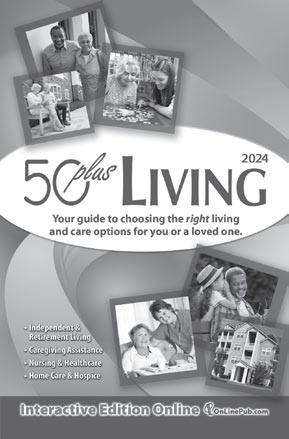









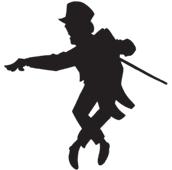
Q. Is it true that pesticides are responsible for people getting Parkinson’s disease?
Although genetics is very important in Parkinson’s disease (PD), environmental exposures also increase a person’s risk of developing the disease. Scientists have known for some time that farm workers who used pesticides, or people who lived or worked near fields where they could inhale drifting pesticides, have an increased risk of PD.
PD was first described in 1817 by Dr. James Parkinson, a British physician. It affects 1 in 100 people over the age of 60. It can also affect younger people. The average age of onset is 60. Research suggests that PD affects at least 500,000 people in the United States.
PD is a complex disorder of the central nervous system. It is the second most
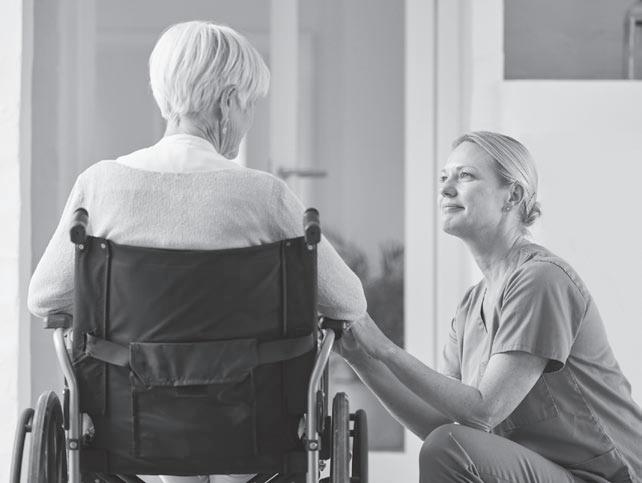
common neurodegenerative disease in the United States, after Alzheimer’s.
The defining symptoms of PD include tremor, slowness of movement, rigidity, and impaired balance and coordination. As these symptoms become more pronounced, patients may have difficulty walking, talking, or completing simple tasks. They also may experience depression, difficulty sleeping, and other problems.
The progression of symptoms in PD may take 20 years or more. In some people, however, the disease progresses much more quickly.
In the early 1960s, scientists determined that the loss of brain cells was causing PD. The cells that were depleted produced dopamine, a chemical that helps control muscle activity. Today, PD is treated with drugs and surgery.
Medications for PD fall into three categories. The first includes drugs that increase the level of dopamine in the brain. The second category affects neurotransmitters in the body to ease some of the symptoms of the disease. The third category includes medications that help control the non-motor symptoms of the disease such as depression.
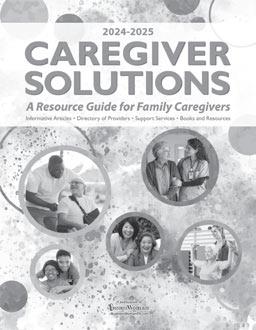





There are three surgical treatments for PD: pallidotomy, thalamotomy, and deep brain stimulation. Because these procedures are invasive, they are usually reserved for severely afflicted Parkinson’s patients who do not get adequate relief from medications.
Surgeons discovered that, by removing or destroying parts of the brain that were “misfiring,” some of the symptoms of PD could be alleviated. Pallidotomy and thalamotomy are two operations that do this. However, they are rarely used today.
Scientists have found that they can mimic the effects of pallidotomy by deep brain stimulation (DBS). With DBS, an electrode is implanted in the brain in a way that calms the abnormal neuronal firing.
Then there is focused ultrasound, which is a noninvasive procedure. Guided by magnetic resonance imaging (MRI), high-intensity, inaudible soundwaves are emitted into the brain.
Where these waves cross, they create high energy. This high energy creates heat, destroying a very specific area in the brain connected to tremor.
A wide variety of complementary and supportive therapies may be used for PD. Among these therapies are standard rehabilitation techniques, which can help with problems such as gait and voice disorders, tremors and rigidity, and cognitive decline. Exercise may help people improve their mobility.
While Parkinson’s is a complex disease, research has progressed a great deal in recent years. Halting the progression of PD, restoring lost function, and even preventing the disease are now considered realistic goals.
Fred Cicetti is a senior and health writer with more than three decades of experience. The Healthy Geezer is devoted to the health questions of seniors who are wondering what is going on with these bodies of ours.











Across
1. Street fleet
5. Not as much
9. Noggin
13. Old Mogul capital
14. Form of ether
15. Cove
17. Roulette color
18. Actress Purviance
19. Verboten
20. Sesame Street Muppet
22. Roof overhang
24. Place for a comb
25. Slump
26. Month before Nisan
28. One of the Three Stooges
1. Walking sticks
2. Plato’s plaza
3. Fetch
4. Rani’s wear
5. Loser at Antietam
6. Take to one’s heart
7. Whale finder
8. Moravian, e.g.
9. Kind of part
10. Crown covering
11. Jessica of Sin City
12. It’s a gas
16. Water tester
21. Mollify 23. Film coating
30. Ivan or Nicholas
31. Clod
35. Lurch
38. Auctioneer’s shout
39. Hawaii’s Mauna ___
40. Any day now
41. Pigpens
43. Heroic deed
44. Zoologist’s foot
45. Miami basketball team
46. Large lizard
48. Rock concert venue
50. Poverty-stricken
51. Increases
52. Hawaii’s ___ Coast
27. Ballerina
29. Antediluvian
30. Mark of perfection
31. Meadow mom
32. Greek village
33. Stable color
34. Info
35. Stadium souvenirs
36. Turn ___ profit
37. Painter Bonheur
38. Take a load off
42. Flat hat
43. Stole
45. Pelvis
47. Weed eater
53. Australian runner
56. Astringent substance
59. Like Darth Vader
61. Bushed
63. Men in Black actress Fiorentino
65. Misfortunes
67. Lyric poet
68. Abatement
69. Old dagger
70. ___ of Wight
71. Volcano feature
72. Feudal worker
73. Prophet
49. Soft-nosed slug
50. Common allergen
52. Oasts
53. Expunge
54. First name in country music
55. Milk dispenser
56. Entirely
57. Emulated Pinocchio
58. Golden rule word
60. Workshop gripper
62. Wading bird
64. Gibbon, for one
66. Bishop’s jurisdiction
 J. Schaaf
J. Schaaf
Spring is a time for all things bright and beautiful. As the days grow warmer and the sun shines brighter, it is a time to refresh our surroundings.
Although generally thought of as a winter style, hygge can be enjoyable and rewarding in spring, too. We remove the bulky warming elements of winter and focus on the light, airy spring décor.
The art of hygge (usually pronounced “hoo-gah” or “hue-gah”) is not only a Danish word; it’s a concept.
Elements associated with hygge include creating an atmosphere of warmth, light, comfort, and connection; an awareness and appreciation for the beauty and joy around us; enjoying simple pleasures; and the feelings of coziness and well-being.
With hygge, we surround ourselves with the things that make life good, like friendship, laughter, security, and more tangible elements like warmth, light, seasonal food, and drink.
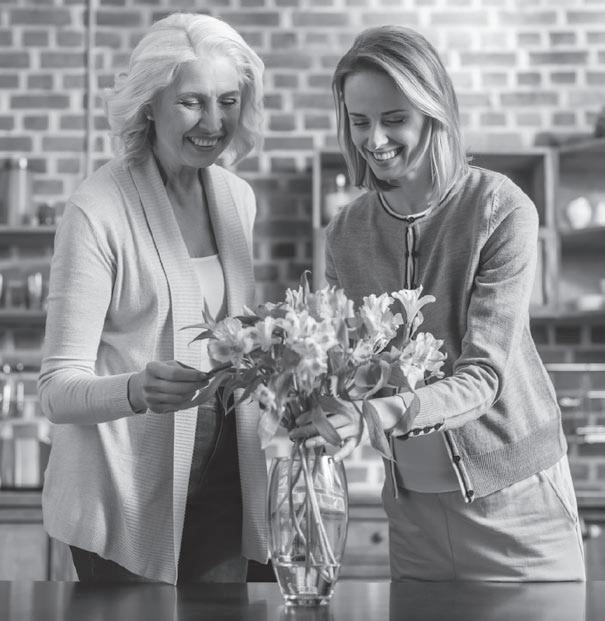
Spring hygge looks like garden parties with lots of flowers, light colors, and taking shelter from the rain in a coffeehouse.
Here are a few favorite ways to practice hygge during the springtime:
Open the windows. Clear out the stale air from having the windows closed tightly all winter, and let the fresh breezes fill the home with the scents of springtime. Open the curtains and raise the shades, letting the spring light in.
Enjoy time in the sun with a nature walk. After the dark days of winter, nothing feels as good as the warm spring sunshine. Spend time outside soaking up the sun’s brightness and getting a dose of vitamin D.
Experience hygge in the spring by taking a nature walk and becoming fully immersed in springtime sights, sounds, and scents. Be attentive to the little






details, like the tiny buds on the trees, the songs of birds, the first robin, or the first crocuses.
Bring fresh flowers into the home. Add a touch of spring hygge to any room with fresh flowers on display throughout the home.
Fresh flowers not only bring in a beautiful decorative element, but they can also make our home smell divine with invigorating scents that are perfect for creating hygge. Scent is such a visceral sense for us humans, and it has a way of getting us to live in the moment.
And that is what hygge is about: embracing each moment and making it blissful.
Declutter. Spring is traditionally associated with spring cleaning, but that can mean more than dusting and sweeping.
Spring is the ideal time to clear out some clutter in the home and eliminate things we no longer need or want. Reducing extra clutter can go a long way toward making our home feel lighter, fresher, and more enjoyable.
Savor the flavors of seasonal fruit and veggies. Spring is a great time to shift our diets from the heavier, warming winter foods, like root vegetables, and begin to add in some lighter, fresher foods that are in season, like greens, lettuces, asparagus, peas, and strawberries.
Enjoy the spring colors. The vibrant colors of new spring growth and flowers are beautiful. Whether we prefer bright, saturated hues or softer pastels, enjoying a splash of spring color can help us appreciate the season thoroughly.
Create a reading nook. We typically think of autumn and winter when we think of hygge, including creating cozy places to curl up with a good book.
For those who love reading, there’s no reason we can’t make it part of a spring hygge routine. Create an outdoor reading nook in a sunny spot near some flowers to enjoy the warm sunshine and floral aroma while reading.
Remember that the home environment can play a crucial part in how we feel and is often a reflection of our mental state. With hygge, we bring in simple elements that invite relaxation and comfort with easy spring décor ideas.
Celebrate spring hygge with all the new life it brings!


www.50plusLifePA.com
Nancy J. Schaaf, a retired RN, worked as a school nurse, a nurse supervisor at a men’s prison, and a health educator. She earned her BSN at Edinboro University. She is a freelance writer whose health articles appear in magazines throughout the U.S. and Canada. She can be reached at nancyjschaaf@gmail.com.

Majestic bald eagles and handsome great horned owls have much in common, though they are in different bird families.
They are large, feathered predators (raptors) that are common throughout most of North America. And they are the earliest birds to nest here in southeastern Pennsylvania.

In this area, pairs of both of these stately species begin courting in December. One can hear the owls of a pair hooting to each other at dawn and dusk through that month. And we notice pairs of bald eagles perched close to each other and calling to one another at any time.
By the second week in February, each female of both these raptors lays one to three eggs in her large, open stick nursery, which is lined with grass or pine needles and built firmly in a crotch of a tall tree.
A female eagle in Lancaster County that I have been watching via an online live camera laid her first egg this year on Feb. 9. And a horned owl female in central Maryland laid her first egg of this year on the same day. A month later, the helpless, white-fluffed young of both kinds will hatch.
Elegant pairs of bald eagles and great horned owls hatch young early, so those youngsters will be independent of their parents by early June, when prey is plentiful. And those immature raptors have all summer and autumn to develop their hunting skills before the hardships of winter set in.
But each pair of these beautiful eagles and owls must work together to raise offspring so early in the year, when cold weather still prevails.
While the slightly larger female of each pair broods the eggs and small babies, guarding them from predators and cold weather, her mate hunts for




the whole family. Male great horns now hunt day and night.
But later, when the eaglets and owlets are feathered and big enough to defend themselves, both parents of each pair hunt prey animals at the same time to keep their rapidly growing youngsters well fed.
Through live cameras and our computer screen, I have been watching a few pairs of bald eagles and great horned owls feeding their young in their treetop cradles in the past few years. The eagles bring larger fish to their young, and an occasional coot, duck, muskrat, cottontail rabbit, and woodchuck. The owls bring lots of rats and muskrats to their young in their nests, plus rabbits and medium-sized birds, including grackles.
There is some competition for food between these raptors. Each adult of both genders and species tears off bits of meat from their victims and tenderly presents that meat, bit by bit, to their babies. However, those dead animals in the nests, until eaten, draw lots of flies.
It’s inspiring and entertaining to watch activities via live cameras in eagle and owl nurseries, without those raptors knowing they are being watched. The lovely feathering of the adults is obvious — and so are the powers of their beaks and talons.
We see the young resting and sleeping, being fed, growing, exercising their flight muscles, and, finally, fledging their nests.
To see these exciting birds and their progeny at home, search in your web browser for “live camera bald eagle nests” or “live camera great horned owl nests.” Then be ready to be thrilled by these large, wild raptors.

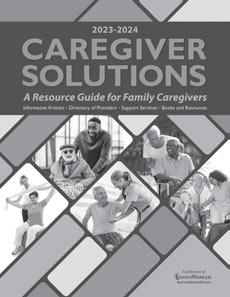
 Miller
Miller
Dear Savvy Senior,
Can you explain to me how the retirement saver’s tax credit works? My wife and I are in our 50s and are looking for creative ways to boost our retirement savings beyond our 401(k). Is this something we may be eligible for?
– Struggling to Save
Dear Struggling,
If your income is low to moderate and you participate in your employer-sponsored retirement plan or an IRA, the Retirement Savings Contribution Credit (a.k.a., “Saver’s Credit”) is a frequently overlooked tool that can help boost your retirement savings even more. Here’s how it works.
If you contribute to a retirement-savings account like a traditional or Roth IRA, 401(k), 403(b), 457, Thrift Savings Plan, Simplified Employee Pension, or SIMPLE plan, the Saver’s Credit will allow you to claim 10%, 20%, or 50% of your contribution of up to $4,000 per year for couples or $2,000 for singles.

Keep in mind that a credit is not the same as a tax deduction — it’s better: While a tax deduction just reduces the amount of your income that is subject to


















taxes, a tax credit reduces your actual tax bill dollarfor-dollar.
To qualify, you must also be at least 18 years old and not a full-time student and were not claimed as a dependent on someone else’s tax return.
And your adjusted gross income (AGI) for 2023 must be below $73,000 or less as a married couple filing jointly, $54,750 or less if filing as head of household, or $36,500 or less if you’re a single filer. These income limits are adjusted annually to keep pace with inflation.
To get the 50% credit, you’ll need to have an income below $43,500 for married couples filing jointly; $32,625 if you’re filing as head of household; and $21,750 if you’re a single filer.
The 20% credit rate applies to couples earning between $43,501 and $47,500; for head of household filers, it’s $32,626 to $35,625; and for individuals, it’s $21,751 to $23,750.
And the 10% rate is for couples with an adjusted gross income between $47,501 and $73,000; for head-of-household filers, $35,626 to $54,750; and for individuals, it’s between $23,751 and $36,500.
please see CREDiT on facing page
The Veterans Administration announced in March that all veterans who were exposed to toxins and other hazards while serving in the military — at home or abroad — are now eligible to enroll directly in VA healthcare.
This means that all veterans who served in the Vietnam War, the Gulf War, Iraq, Afghanistan, the Global War on Terror, or any other combat zone after 9/11 are eligible to enroll in VA healthcare without first applying for VA benefits.

Additionally, veterans who never deployed but were exposed to toxins or hazards while training or on active duty in the United States are eligible to enroll.
This expansion of VA healthcare eliminates the phased-in approach called for by the PACT Act — meaning that millions of veterans are becoming eligible for VA healthcare up to eight years earlier than written into law.
VA encourages all eligible veterans to visit va.gov/pact or call (800) MYVA411 to learn more and apply for VA healthcare.

Q. I am looking for a way to follow sports scores from different games on my phone. Does that exist?
A. There are a few options. If all the games are in one league, such as MLB or the NBA, leagues usually have apps that can keep you up to date. Specific features vary within each app, but league-focused apps are a good place to start.
Following a group of teams from different sports altogether requires a little creativity. The ESPN app permits you to create custom alerts for individual teams, and those alerts are delivered to your smartphone.
You can craft sophisticated notifications using the ESPN app, which makes it a more complete solution. The tradeoff is that it requires more work to set up.

For Apple iPhone users, the Apple Sports app (free download on the App Store) is a fresh take on a universal scoreboard.
When you first launch the app, you will be prompted to identify your favorite leagues and teams. The challenge here is that the app is new, and not every sport is represented. Apple promises there are more stats to come.
The marriage of sports scores and smartphones seems ideal. Unfortunately, following a mix of scores from different sources requires extra effort up front.
Q. What happens if I lose the password for my AppleID?
A. If you prepare ahead of time, a lost AppleID password is a minor nuisance. If not, there is an excellent chance you will lose everything.
Lost passwords can have serious consequences for your family as well. If you die suddenly, and your password is known only to you, all your data and photos are lost forever.
The preservation of digital data is a big topic. However, there are simple steps you can take right now to avoid future problems.
Go to the Settings app on your iPhone and tap your name at the very top of the screen. This will open your iCloud settings. Next, tap Sign-in and Security.
There are two vital settings to configure here, Recovery Contacts and
CREDiT from facing page
Here’s an example of how this works. Let’s say that you and your wife earned $75,000 in 2023. Over the course of the year, you contributed $4,000 to your employer’s 401(k) plan. After deducting your 401(k) contribution, your adjusted gross income (AGI) on your joint return is now $71,000.
Since your AGI puts you in the 10% credit bracket, and you’ve contributed the $4,000 maximum that can be considered for the credit, you are entitled to a $400 Saver’s Credit on your tax return.
It’s also worth mentioning that the Saver’s Credit is in addition to any other tax benefits you get for your retirement contributions.
So, in the previous example, not only would you be entitled to a $400 credit, but you would also be able to exclude the $4,000 401(k) contribution from your taxable income. So, if you’re in the 12% tax bracket, this translates to an additional $480 in savings, for a total of $880.
Legacy Contacts.
A Recovery Contact is a trusted friend or family member who is authorized to send you a “recover password” message, which will allow you to set a new password for your AppleID without the old password.
A Legacy Contact is someone you designate to receive an archive of all your digital data stored on iCloud in the event of your passing.
Configuring these settings requires that everyone involved has up-to-date software. If that is not an option for you, a somewhat less reliable alternative is to print out a recovery code.
These features are fairly new, so there is a good chance this is probably the first time you have heard these suggestions.
Protect yourself and your family by setting up Recovery and Legacy Contacts today.
Q. I am an Android user. Is there something similar to Apple’s Legacy Contact for my Google Photos or other data?
A. Google does not have a Legacy Contact feature, although they do have a process that enables a somewhat similar result: the ability to designate an Inactive Account Manager.
Once established, the designee can access your Google account without a password after a set amount of time when the account is inactive.
This is not exactly like a Legacy Contact. The minimum time for an account to be marked as inactive is three months. After the timeout is passed, your data can be retrieved.
Until Google streamlines this process, this is the only option right now. To get started, visit myaccount.google.com/inactive and follow the prompts.
As I pointed out previously, preserving your data is much easier when it is done before something tragic occurs. Do this today.
Bob has been writing about technology for over three decades. He can be contacted at techtalk@bobdel.com.
To claim the Saver’s Credit, you will need to fill out Form 8880 (see irs.gov/ pub/irs-pdf/f8880.pdf) and attach it to your Form 1040 or 1040NR when you file your tax return.
For more information on the Saver’s Credit, see IRS Publication 590-A “Contributions to Individual Retirement Arrangements” (irs.gov/pub/irs-pdf/ p590a.pdf).
The IRS also offers an online quiz you can take to help you determine if you qualify for the Saver’s Credit. To access it, go to irs.gov/help/ita and click on “Do I Qualify for the Retirement Savings Contributions Credit?” under the “Credits” tab.
Send your senior questions to: Savvy Senior, P.O. Box 5443, Norman, OK 73070, or visit savvysenior.org. Jim Miller is a contributor to the NBC Today show and author of The Savvy Senior book.
 Doris Montag
Doris Montag
Overalls were originally essential workwear intended to be worn over the wearer’s clothes. The design of overalls is a bib attached to trousers with over-the-shoulder straps.
Bib overalls, also known as dungarees, also had an enlarged crotch section for the mobility needed to climb on the train engine, the tractor, and fishing boats.
Originally, overalls were made from cotton denim or heavy canvas for rough wear. For fishermen, overalls were made of water-resistant or waterproof fabrics.
Durability and comfort were the main considerations for work overalls. The design
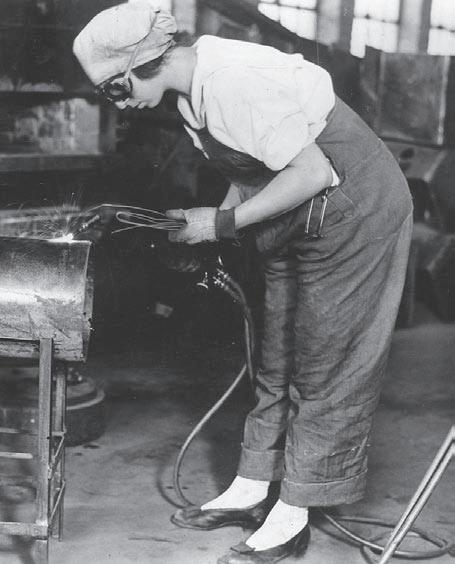

was also more comfortable for those with a big stomach.
In the 1700s, linen canvas and osnaburg, a course flax fabric, were used in overalls.
There is evidence that protective denim overalls were worn in the late 1700s by enslaved people. Denim material was sturdy. It also created a stark visual contrast between the field hands and their owners.
The 1778 military uniform regulations for the U.S. Continental regulars stated that overalls, made of linen for summer and wool for winter, would be issued to replace breeches and stockings. This was the first purposeful use of
Think you or someone you know would make an interesting profile story for 50 plus Life?
We are looking for central Pennsylvanians over age 50 who have a unique hobby, passion, or history of volunteer work, or who are a part of an interesting local club.
Ideal story candidates are willing to talk about themselves and to be photographed.


Note: Please get your nominee’s permission before submitting them!
Your name: _______________________________________________________________
Your address: ____________________________________________________________________
Nominee’s name (if not self):
Nominee’s town of residence:
Nominee’s phone: __________________________________ Email:
Why they would make a great story:



Your phone: ________________________________________ Email:_____________________________________________
Megan Joyce, editor, at mjoyce@onlinepub.com or send via mail to 50plus Life, p.o. Box 8049, Lancaster, pA 17604.
overalls as clothing to be worn over undergarments rather than over clothes.
Meanwhile, civilians continued to wear overalls as protective clothing except in hot weather when they, too, wore overalls over undergarments.
After the Civil War, denim overalls were worn by sharecroppers, which continued the negative perception that denim overalls were for Black and poor white Americans.
(In the 1960s, early civil rights workers wore denim overalls, which were still associated with sharecropping. Initially symbolic, overalls were practical because of frequent mending of tears from attack dogs and high-pressure hoses. Ultimately, the activists elected to be clean cut and well dressed to elicit a more positive response.)
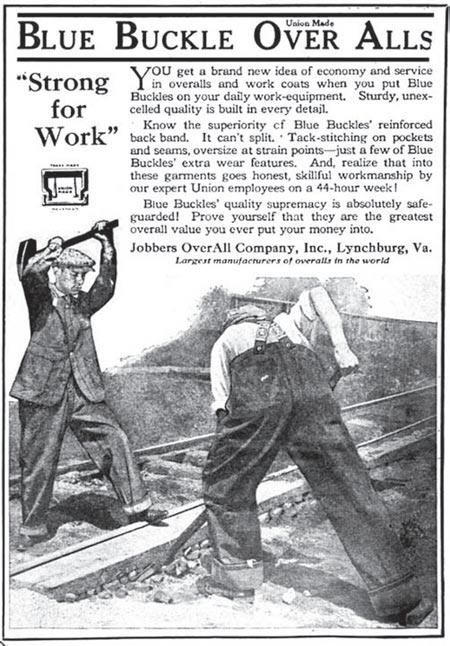
Strauss & Company patented the iconic Levi’s 501 Blue Jean with rivets in 1873. While patented as overalls, they were not. They were simply trouser overalls, also known as waist overalls, intended to be worn over undergarments.
These first “jeans” consisted of suspenders attached to denim pants with buttons. The first mass-produced jeans were made by Levi Strauss and Jacob Davis in the 1890s.
Steam locomotive engineers and firefighters adopted overalls for their work. They needed rugged apparel to withstand the heat, grease, and oil from their jobs.
Until World War I, overalls were worn mainly by men or as playsuits for children. When women entered the war workforce, their everyday garments were too dangerous for factory work.
Women’s overalls for work were eventually followed by fashion overalls in lightweight cottons with special cuts, such as sweetheart necklines, waist-cinching features, dainty pockets, and flared-leg styles.
In 1920, a Wisconsin clothing manufacturer began producing engineer caps of a blue-and-white-striped material. The matching striped cap and overalls became the universally recognized engine-crew uniform, along with matching denim overcoats and leather work gloves.
The engineer’s overalls had pockets for tools, such as a wrench for mechanical adjustments and a temperature gauge to take heat readings. There was also a special pocket for a watch.
The first patent for bib overalls was filed by Lee Jeans in 1921. Previously, companies such as Carhartt were manufacturing overalls, but Lee Jeans was the first to patent the cut and style.
Overalls are still relevant today for much the same reasons as in the past.
Doris Montag is a homespun historian and an exhibit curator who researches and displays historical collections of ordinary things, such as can openers, crochet, toy sewing machines, hand corn planters, powder compacts, egg cartons, and more. Contact or follow her on Facebook, HistoryofOrdinaryThings.




Listings with a screened background have additional information about their services in a display advertisement in this edition. This is not an all-inclusive list of agencies and providers. These advertisers are eager to provide additional information about their services.

Year est.: 2012
counties Served: Berks, Chester, Cumberland, Dauphin, Lancaster, Lebanon, Lehigh, Montgomery, Schuylkill, York
rns: Yes
LPns: Yes
cnAs: Yes
home Aides: Yes
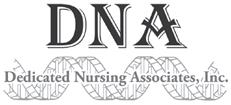
Year est.: 2006
Age in PLAce home c Are 1 (888) 990-4555 www.aiphc.com
medicare certified?: No
other certifications and Services: Now accepting new clients. We are a licensed, nonmedical home care service, providing quality support to seniors and those with physical disabilities. Our services include: respite care, recovery care, Alzheimer’s and dementia care, personal care, home support care, errands, and transport. Now accepting Act 150 waiver, OBRA waiver, CHC waiver, private pay. Now hiring CNAs, caregivers, and home health aides. Offering $1,000 sign-on bonus.
dedic Ated nurSing ASSociAteS, inc. (570) 523-1810
cnAs: Yes
counties Served: Adams, Columbia, Cumberland, Dauphin, Franklin, Lancaster, Lebanon, Lycoming, Montour, Northumberland, Perry, Snyder, Union, York
rns: Yes
LPns: Yes

Year est.: 2007
counties Served: Lancaster
rns: Yes
LPns: No
cnAs: No
home Aides: Yes

Year est.: 2002
counties Served:
Senior Helpers of Exton – (484) 247-4714
www.dedicatednurses.com
home Aides: Yes
medicare certified?: Yes
other certifications and Services: DNA is dedicated to all of your home care needs. Our services include but are not limited to: bathing, dressing, feeding, meal preparation, light housekeeping, medication reminders, errands, and appointments.
L AndiS At home (717) 509-5800
www.landisathome.org
medicare certified?: No
other certifications and Services: Graceful transitions – move management, downsizing; senior servant – bookkeeping; and transportation.

Year est.: 1994
counties Served: Lancaster, York
rns: No
LPns: No
cnAs: No
home Aides: Yes

BY Your Side home c Are (717) 394-5111
www.byyoursidecare.com
medicare certified?: No
other certifications and Services: Personal care, ambulation, and transfers. Companionship, light housekeeping, meal prep, medication reminders, and respite care.

homeland hospice: (717) 221-7890
Year est.: 2009
homeland Palliative care: (717) 857-7403
Year est.: 2022
homeland homecare: (717) 221-7892
Year est.: 2016
homeland homehealth: (717) 412-0166
Year est.: 2017
counties Served: Adams, Cumberland*, Dauphin*, Franklin, Fulton, Juniata, Lancaster, Lebanon*, Mifflin, Northumberland, Perry*, Schuylkill, Snyder, York*
*Homeland HomeHealth currently serves five of 14 counties.
rns: Yes
LPns: Yes
cnAs/home Aides: Yes
direct care Workers: Yes
rns: Yes
LPns: No
cnAs: Yes
home Aides: Yes
Senior Helpers of Harrisburg – (717) 920-0707
Senior Helpers of Hershey – (717) 644-9246
Senior Helpers of Lancaster – (717) 738-0588
Senior Helpers of York – (717) 893-2315
medicare certified?: No
other certifications and Services: Alzheimer’s and dementia care, Parkinson’s care, companion care, personal care, respite care, VA benefit assistance, chronic disease care.

Year est.: 1978
counties Served: South-central through northeastern Pennsylvania and northern Maryland
rns: Yes
LPns: Yes
cnAs: Yes
homeLAnd At home
www.homelandathome.org
Pt/ot/Speech therapists: Yes
Social Workers: Yes
Spiritual counselors: Yes
complementary therapies: Yes
medicare certified: Yes
other certifications and Services: Homeland at Home is a community outreach of Homeland Center, a nonprofit CCRC that has served our region with excellent and benevolent care since 1867. Our expert team is dedicated to providing a continuum of At Home services — from nonmedical personal assistance to skilled nursing and compassionate care. We are privileged to care for you and your loved ones … any place you call “home.”
We offer 13 months of bereavement support as well as community and staff educational programs. Please call for details.
SPiritruSt Luther An home c Are & hoSPice
(800) 840-9081
www.spiritrustlutheran.org
home Aides: Yes
medicare certified?: Yes
other certifications and Services: Home health care, in-home support, hospice care, palliative care, grief support, Medicaid certified. Physical, occupational, and speech therapy.
Listings with a screened background have additional information about their services in a display advertisement in this edition. This is not an all-inclusive list of agencies and providers. These advertisers are eager to provide additional information about their services.
Year est.: 2003
counties Served: Cumberland, Dauphin
rns: No
LPns: No
cnAs: No
home Aides: Yes
By Randal C. Hill
medicare certified?: No
other certifications and Services: Visiting Angels is a leading provider of elder care since 1998. We help older adults live independently and comfortably in their own homes. Services are customized and tailored for best outcomes.
One Monday evening in 1957, the switchboard at the London office of the BBC came ablaze with blinking lights, as overwhelmed operators frantically explained that, no, they had no information about where one could purchase a spaghetti plant.
That’s not a typo. The English current-affairs program called Panorama — much like our 60 Minutes — had shown a video clip allegedly of Swiss farmers harvesting freshly grown spaghetti in their annual spaghetti harvest.
The next day on the London news, the BBC admitted that what they had aired was an April Fools’ Day prank.

Twenty-three years later, again on April 1, those fun-loving BBC Brits announced that Big Ben’s clock face was going digital, and that whoever called the office first would win the clock’s massive hands. It is unknown how many people fell for that one.
The playing of practical jokes has been around for centuries, but exactly when folks started to embrace them is anybody’s guess. Over the years, historians have cited numerous rites and festivals as possible beginning points, but few have agreed about just when April Fools’ Day became somewhat of a holiday.
One thing for sure is that much chuckle-producing activity has transpired in our lifetimes here in the USA:
• April 1, 1985, saw the printing of a Sports Illustrated magazine article about a rookie pitcher named Sidd Finch, who could throw a fastball 168 miles an hour. (The current record is 106 mph.)
• Even the folks at NPR (National Public Radio) have exhibited a first-ofApril sense of humor. In 1992, the Talk of the Nation show aired Richard Nixon (voiced by master imitator Rich Little) announcing another run
• for the presidency with the slogan, “I didn’t do anything wrong, and I won’t do it again.”
• Apparently, fast-food folks also enjoy a good April 1 hoax. In 1996, the Taco Bell chain announced it had purchased the Liberty Bell in Philadelphia and would rename it the Taco Liberty Bell. Two years later, Burger King folks promised that a “left-handed Whopper” was forthcoming.
• Over the years, some people have fallen for the same old absurdities, which have included being sent to a hardware store for a left-handed wrench, to a pharmacy for “pigeon’s milk,” or to a bookstore for a copy of The History of Eve’s Grandmother.
• Of course, not everybody has a sense of humor. In 2021, the Thailand police force announced that posting or sharing false news online could lead to a maximum of five years’ imprisonment. (C’mon, guys, lighten up!)
While some April Fools’ Day hoaxes, pranks, and practical jokes have garnered praise for their innovation and creativity, some people — usually victims — have described such antics as crude, insensitive, or rude.
Whatever our take on this issue is, we should be on our guard when it comes to April 1 and what is announced in newspapers, on radio and TV stations, and on internet websites that keep us informed — and some long-running traditions alive. You have been warned.
Anybody hungry for some freshly harvested spaghetti?
Although Randal C. Hill’s heart lives in the past, the rest of him resides in Bandon, Ore. He can be reached at wryterhill@msn.com.
 Suzy Cohen
Suzy Cohen
In a world still grappling with the aftermath of COVID-19, many find themselves caught in the enigmatic web of long COVID, a condition that stretches the boundaries of our understanding of post-viral syndromes.
Long COVID, or post-acute sequelae of SARS-CoV-2 infection (PASC), presents a mosaic of symptoms ranging from muscle aches and fatigue to brain fog and loss of smell. It affects millions globally, with a notable prevalence among women aged 35-49.
The symptoms and methods of treatment are too numerous to list here, but I just wrote about it all in great detail. So now I have a free e-book to offer you (details below) where you can learn more: Navigating the Aftermath: 8 Strategies to Recover from Long COVID’s Autoimmune Effects

The most common symptoms of long COVID include problems with
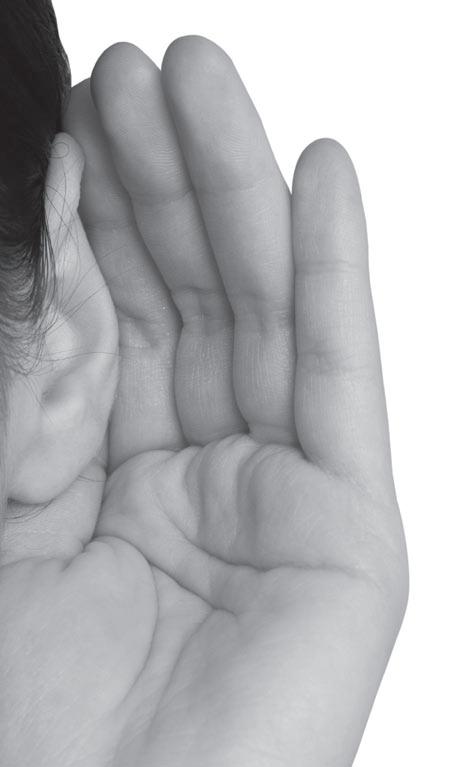
brain fog, headache, fatigue, shortness of breath, anxiety, and muscle aches. You may have even developed a new autoimmune condition. That wouldn’t surprise me because of a phenomenon called molecular mimicry that occurs with this virus and many others.
The persistence of long COVID across different demographics, irrespective of the initial infection’s severity or vaccination status, underscores the complexity of its impact on the healthcare system.
Doctors are inundated with new patients. Thank goodness for telehealth Zoom calls because most people with long COVID are exhausted! Some had disabilities to begin with, prior to these new symptoms.
With the highest rates observed in the United States, our clinics are now
please see CoViD on facing page


 Randal C. Hill
Randal C. Hill
Late in 1975, there would have been no reason for you to know the name of Gary Dahl.
By the beginning of the next year, though, there’s little doubt you would have become aware of, if not his name, his quirky creation that had made him a pop-culture phenomenon.
Dahl owned a California advertising agency that specialized in radio and TV ads. Business had fallen off recently, and the discouraged 38-year-old was frequently casting about to change his fortunes with a clever (and marketable) idea.
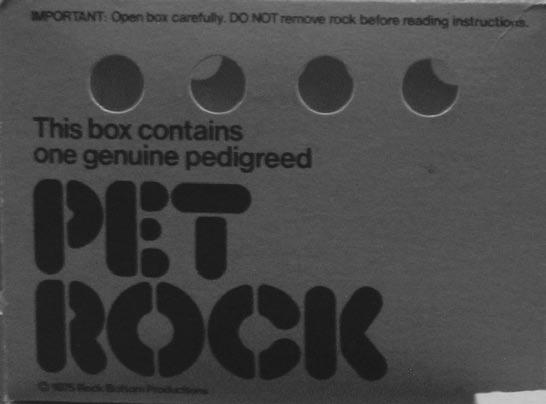
One night, he and some pals were drinking at their favorite hangout in Los Gatos, a town in the rapidly growing Silicon Valley. Dahl’s pals were complaining about all the hassles and expenses involved with their household pets.
Dahl, though, smiled and joked that he had no such problems, as his domestic pet was a rock. Laughter followed, as did a few more drinks.
But back home, Dahl began writing the Pet Rock Training Manual , a 36page, chuckle-inspiring booklet filled with puns, jokes, and illustrations of various rocks in (in)action.
He lightheartedly explained that Pet Rocks required no feeding, walking, bathing, grooming, or vet visits. They were hypoallergenic and didn’t bark, bite, or have accidents on the floor.
They were good at obeying certain commands — “stay,” “play dead” — but admittedly required some owner assistance with “fetch,” “come,” and “roll over.”
He designed a cardboard pet carrier complete with ventilation holes and a bedding of straw or shredded paper.
The rocks themselves — smooth stones from a beach in Baja California —
facing significant challenges in taking care of people with long COVID. There is no single way to treat each person and no single remedy that works.
Only through experimentation and good supervision can you get on top of this. And you can — you’re stronger than you think.
Addressing long COVID requires a multifaceted approach that goes beyond conventional medication, embracing natural remedies, vitamins, and holistic practices, such as acupuncture and massage therapy.
Among the natural remedies, I think resveratrol, B-complex vitamins, vitamin D3, ginkgo, and magnesium should be considered. There are many others — it just depends on the symptoms you have.
Of course, natural remedies are not a substitute for proper medical care and treatment with your doctor. Think of vitamins and herbs as helpers to support mental clarity, immune function, and overall well-being. Complementary therapies and a supportive network can further enhance
came from a local sand and gravel company and cost one penny each. The straw or shredded paper wasn’t much more. Dahl’s biggest expense was the cardboard carrier.
He convinced two friends to invest $10,000 each in his product, and Pet Rocks soon began appearing in Bay Area novelty stores and at gift shows.
Word and interest spread quickly across the country, especially after Newsweek ran an illustrated feature on the preposterous pretend pet. Dahl appeared twice on The Tonight Show, and someone named Al Bolt even released a single record called “I’m in Love with My Pet Rock.”
By Christmas, 100,000 Pet Rocks were being bought daily.
Following the holidays — and after 1.5 million units had changed hands — the fad died as quickly as had the hula hoop.
But by then Dahl, who earned 95 cents’ profit on each $3.95 sale, had pocketed over $1 million. He gifted each newly wealthy investor with a shiny new Mercedes and then purchased a Los Gatos hillside mansion complete with his own Mercedes in the garage.
To many people, Pet Rocks were a silly “craze du jour,” seen as a statement about the absurdity of consumer culture. To others, though, the success of the novelty became a testament to clever marketing.
Whichever, Dahl’s item had made a lasting impact on the toy industry and American popular culture.
And it had all been fun. Dahl told People magazine, “You might say we packaged a sense of humor.”
Although Randal C. Hill’s heart lives in the past, the rest of him resides in Bandon, Ore. He can be reached at wryterhill@msn.com.
your resilience.
In navigating the recovery from long COVID, strategies such as prioritizing rest, maintaining a nutritious diet, staying hydrated, engaging in gradual exercise, managing stress, and seeking medical guidance are essential.
As we continue to confront the realities of long COVID, it’s vital to remember the strength and resilience inherent within each of us.
By embracing both conventional and alternative approaches, and by supporting one another, we can navigate the path to recovery and reclaim the vibrancy of life disrupted by this enduring pandemic shadow.
In my e-book, which is available for free to everyone at suzycohen.com/ long-covid, I discuss both natural and pharmaceutical ways to help feel better, far beyond the scope of this article.
This information is not intended to diagnose, prevent, or treat your disease. For more information about the author, visit suzycohen.com.
 Terri Schlichenmeyer
Terri Schlichenmeyer
That bumper sticker on your car is never coming off.
The one beneath it won’t, either, but that’s OK. In a way, they serve as a kind of political history for you, going back a number of years, but wouldn’t a book be easier? Yeah, it would, so revisit history with these great books.
Readers who’ve been around long enough to remember when John Kennedy was assassinated will want to read Kennedy’s Avenger by ABC News correspondent Dan Abrams and David Fisher (Hanover Square Press) because this book takes readers past the first shock of that week and into the second one: the shooting of Lee Harvey Oswald on live TV.

By various authors
Abrams and Fisher then write about Jack Ruby’s trial, which happened some time later and isn’t usually something covered by the history books. It’s fascinating all the same. This is the perfect read for conspiracy theorists, 20th-century historians, and fans of law-based stories.
c. 2021, various publishers
Various page counts
You almost can’t understand John Kennedy’s presidency without first knowing about his father, Joseph.
In The Ambassador: Joseph P. Kennedy at the Court of St. James’s 1938-1940 by Susan Ronald (St. Martin’s Press), you’ll read about Roosevelt’s America; Great Britain, pre-World War II; and about how Joseph Kennedy wrangled himself an appointment to one of this country’s most prestigious, highestregarded ambassadorships to England.
Hint: It didn’t go well at all. Don’t you just love a good scandal?
Speaking of a good scandal, look for Watergate’s Forgotten Hero: Frank Wills, Night Watchman by Adam Henig (McFarland).
It’s the story of the then-24-year-old night watchman who was on guard
Puzzles shown on page 7.

duty the night the Watergate Hotel was broken into: his life, his struggles, and what happened to him in the aftermath of the newsmaking crime.
Wills, the only African American attached in any way to the Watergate scandal, was the one who called the police. They arrested five burglars, and the rest is history …
And finally, relax a little and read a presidential love story inside The Man I Knew: The Amazing Story of George H.W. Bush’s Post-Presidency by Jean Becker (Twelve).
Becker, you may remember, was Bush’s chief of staff, and she begins her story the “morning after” Bush was “fired” by the American people, losing his seat in the Oval Office to Bill Clinton in November of 1992.
Becker was there that day, and she writes about how the former president dealt with the disappointment and the optimism that allowed him to turn the setback into a chance to benefit others, over time.
Becker remained close friends with the former president until the end of Bush’s life; because of that accessibility, this deeply personal peek inside the lives of the elder Bush family is an absolute joy to read.
Ah, but you want to know about some other guy in the White House, and you’re in luck: Kindly ask your favorite bookseller or librarian for help. They’ll guide you toward the book you need about the guy you voted for (or not). To begin, just get in the car …
The Bookworm is Terri Schlichenmeyer. Terri has been reading since she was 3 years old, and she never goes anywhere without a book. She lives on a hill in Wisconsin with two dogs and 14,000 books.

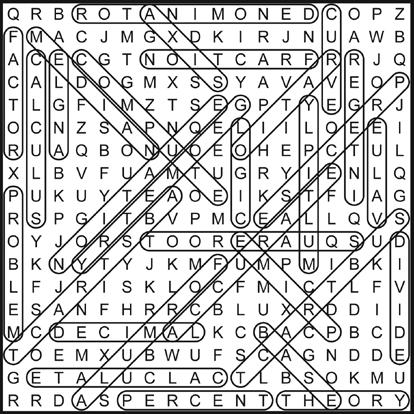

I have appraised all types of clocks — tall case clocks, carriage clocks, mantle clocks, etc. — for clients in all parts of the world. Clock collectors have been surprised or even stunned when an otherwise reliable clock just stops working — possibly for no good reason.
But there is a very good reason why a clock suddenly stops working: Moving a clock is the single most common explanation for why a clock fails to keep time.
Clocks are homebodies. Moving a clock to a different location may change the clock’s accuracy; some clocks may stop working altogether.
Clocks of all types find comfort in a certain spot and react to the temperature and humidity. Once you find a place in your home where a clock is working well, don’t move it.
There are some simple ways to keep your clocks working well.
1. Do you want a clock to keep accurate time? Wind it on a regular schedule, just like clockwork, as the old saying goes. Pick a day of the week and a time of day to wind your clock, and stay on that schedule.
2. Be sure to keep a clock fully wound, and don’t be overzealous when winding. If a clock will not easily wind with the key or the hands of a clock do not move, don’t force them. Consult an expert.
3. Do not place a clock near a window, drafty area of a room, or access doors. Clocks don’t like to be close to air conditioning units, HVAC returns or vents, radiators, or attic or garage-access doors.
4. Remember the old rhyme: “Clockwise for time, counterclockwise for chime.” You should move the hands of a clock clockwise to set the time, and move the hands counterclockwise to set the chime. This will help your clock run properly.
5. If you intend to move or relocate your clock, it is wise to remove the pendulum first to keep it out of harm’s way.
6. The pendulum’s length is an indicator of how the clock will run. The longer the pendulum, the slower the clock will run. The shorter the
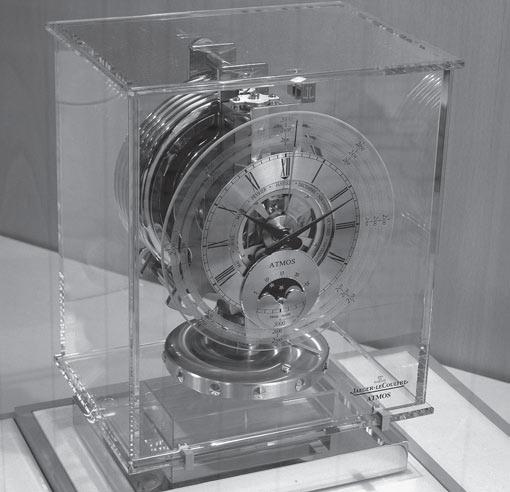
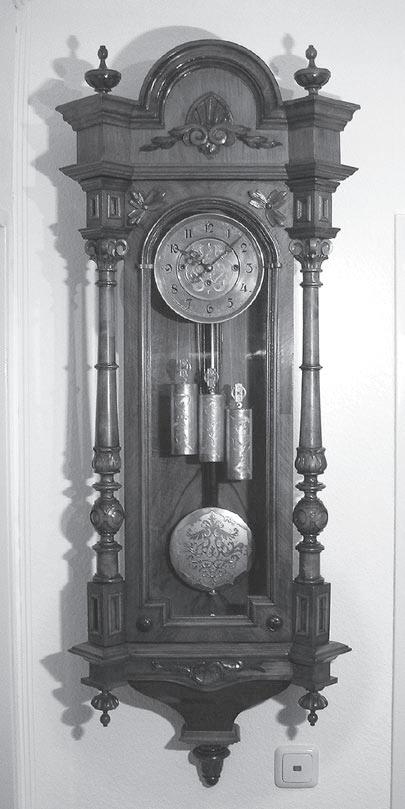
pendulum, the faster the clock will run.
Some clocks have F (fast) and S (slow) marked on the interior clockworks. You can adjust your clock, and this simple adjustment of the F/S lever can help when a clock runs too slow or too fast.
7. Also, if you have a key to your clock, don’t give it up to anyone. It is a vital piece of equipment that is necessary to keep your clock working. Like your car keys, it will be a big headache if you lose your clock key.
8. Listen to the beat. If your clock misses a beat, it may be on an uneven surface. Clocks that use pendulums or atmospheric-driven clocks, known as Atmos clocks, need to be on a level surface to run properly.
If your floors are warped or your mantle, bookcase, table, or other flat surface is crooked, your clock may not keep accurate time.
Remember, moving a clock may damage it. If you intend to synchronize or move a clock, be it a wall clock or a tall case clock, it is wise to consult with a clock professional first. Clocks featuring chimes and gongs may require special expertise.
Ph.D. antiques appraiser, author, and award-winning media personality Dr. Lori presents antique appraisal events nationwide and appears on Netflix’s King of Collectibles and History channel’s The Curse of Oak Island and Pawn Stars Do America. Visit drloriv.com, watch videos at youtube.com/drloriv, or call (888) 4311010.

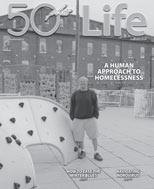
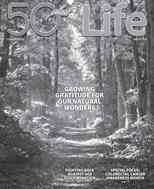


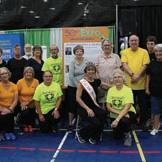
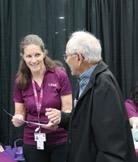
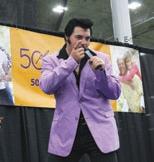
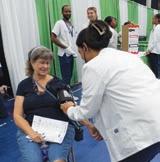



9
9
9
9